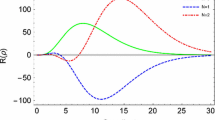Abstract
The tachyon problem is considered on the basis of the kinematics of the extended hyperbolic space of relativistic momenta, including a two-sheet hyperboloid of momenta of subluminal particles, a cone of massless particles propagating at the speed of light, and a one-sheet hyperboloid of momenta of superluminal particles. The concept of mutually polar four-dimensional momenta is introduced. It is shown that the four-momentum corresponding to infinite velocity is polar to the rest frame on the upper part of a two-sheet hyperboloid . The Lorentz transformation is found that translates an arbitrary four-momentum of a tachyon into a four-momentum which time component is zero (tachyon’s proper frame of reference). The kinematics of the decay of a tachyon into a particle and its antiparticle (neutrino-antineutrino) in an arbitrary frame of reference and in the tachyon’s proper frame is considered. A test for detecting such a process is proposed.
Similar content being viewed by others
REFERENCES
A. J. Silenko, P. Zhang, and L. Zou, “Relativistic quantum-mechanical description of twisted paraxial electron and photon beams,” Phys. Rev. A 100, 030101 (2019).
T. Roger, A. Lyons, N. Westerberg, S. Vezzoli, C. Maitland, J. Leach, M. J. Padgett, and D. Faccio, “How fast is a twisted photon,” Optics 5, 682–686 (2017).
F. Bouchard, J. Harris, H. Mand, R. W. Boyd, and E. Karimi, “Observation of subluminal twisted light in vacuum,” Optics 3, 351 (2015).
P. Saari, “Reexamination of group velocities of structured light pulses,” Phys. Rev. A 97, 063824 (2018).
Z. Chen, Y. Ho, P. Wang, Q. Kong, Y. Xie, and W. Wang, “A formula on phase velocity of waves and application,” Appl. Phys. Lett. 88, 121125–121125 (2006).
S. Huang, F. Wu, and B. Hu, “Formula for the phase velocity of electromagnetic waves,” Phys. Rev. E 79, 047601 (2009).
A. Tyapkin, “Experimental indication on the existence of tachyons obtained while studying Cherenkov radiation,” Preprint (Dubna, 1999).
R. Ehrlich, “Review of the empirical evidence for superluminal particles and the 3+3 model of the neutrino masses,” arXiv: 1711.09897v2 (2019).
R. Ehrlich, “The KATRIN neutrino mass results: An alternative interpretation,” Lett. High Energy Phys. 199 (2021).
G. Feinberg, “Possibility of faster than light particles,” Phys. Rev. 159, 1089–1105 (1969).
M. Green, J. Schwartz, and E. Witten, Superstring Theory (Cambridge Univ. Press, New York, NY, 1987), Vol. 1.
A. Arroyo, High Energy Phys. 10, 56–65 (2009).
W. Pauli, Theory of Relativity (Dover, New York, 2013).
V. Fock, The Theory of Space, Time and Gravitation, 2nd ed. (Pergamon, Paris, 1964).
A. Berezin, Y. Kurochkin, and E. Tolkachev, Quaternions in Relativistic Physics (Minsk, 1989) [in Russian].
A. Bogush, Y. Kurochkin, and F. Fedorov, “Lobachevskian space vectors and relativistic kinematics,” Sov. Phys. Dokl. 236, 58–64 (1977).
K. Xiao, “Tachyon field in loop cosmology,” Phys. Lett. B 811, 135859 (2020).
H. Farajollahi, A. Ravanpak, and G. Fadakar, “Interacting agegraphic dark energy model in tachyon cosmology coupled to matter,” Phys. Lett. B 711, 225–231 (2012).
U. Jentschura, I. Nandori, and R. Ehrlich, “Calculation of the decay rate of tachyonic neutrinos against charged-lepton-pair and neutrino-pair Cerenkov radiation,” arXiv: 1709.07711 [hep-ph] (2020).
V. D. Ashitkov, T. M. Kirina, and A. P. Klimakov, “Study of advanced particles from the point of view of the tachyon hypothesis,” Izv. Akad. Nauk SSSR, Ser. Fiz. 49, 7–15 (1985).
V. Perepelitsa, “Tachyon Michelson experiment,” Phys. Lett. 67, 471–473 (1977).
R. Ehrlich, “Neutrino mass2 inferred from the cosmic ray spectrum and tritium beta decay,” Phys. Lett. B 493, 229–232 (2000).
F. I. Fedorov, Lorentz Group (Nauka, Moscow, 1974) [in Russian].
Author information
Authors and Affiliations
Corresponding authors
Ethics declarations
The authors declare that they have no conflicts of interest.
Rights and permissions
About this article
Cite this article
Kurochkin, Y.A., Shaikovskaya, N.D. Superluminal Particle Motion from the Hyperbolic Momentum Space Point of View. Phys. Part. Nuclei Lett. 19, 638–641 (2022). https://doi.org/10.1134/S1547477122060140
Received:
Revised:
Accepted:
Published:
Issue Date:
DOI: https://doi.org/10.1134/S1547477122060140




